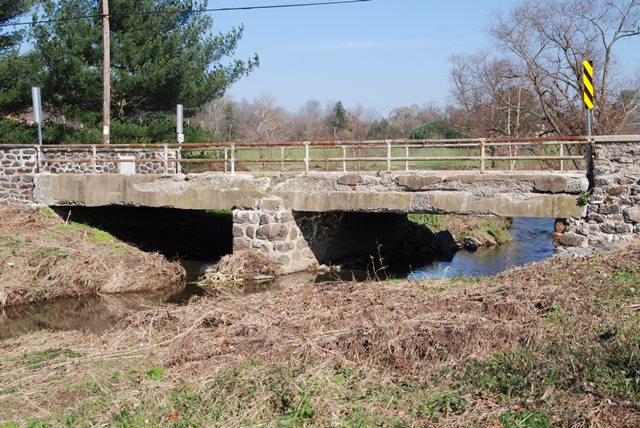We Recommend:
Bach Steel - Experts at historic truss bridge restoration.
Creek Road Bridge

Primary Photographer(s): Elaine Deutsch
Bridge Documented: November 9, 2012
Rural: Chester County, Pennsylvania: United States
1914 By Builder/Contractor: Corcoran Construction Company of West Chester, Pennsylvania and Engineer/Design: Nathan R. Rambo
Not Available or Not Applicable
21.0 Feet (6.4 Meters)
48.0 Feet (14.6 Meters)
18 Feet (5.49 Meters)
1 Main Span(s)
10530

View Information About HSR Ratings
Bridge Documentation
View Archived National Bridge Inventory Report - Has Additional Details and Evaluation
This bridge is one of the earliest and least altered examples of a locally common but nationally unusual bridge type... a steel stringer bridge with concrete jack-arch decks. This example retains original pipe railings, something that can not be said for all examples of this type in the county. It rests on stone abutments.
Visit the page for another similar bridge for good photos of the type of jack-arch deck found on these bridges.
Information and Findings From Pennsylvania's Historic Bridge InventoryDiscussion of Bridge The 2 span, 50'-long, steel stringer bridge built in 1914 has pipe railings, a concrete jack arch deck, and rubble masonry abutments. U-shaped stone wingwalls with parapets enclose the approach roadway. It is among the 21 earliest examples of the steel stringer with jack arch deck type and design from 1905 to 1914, identified in the state, and one of the four earliest identified, prototypical examples from 1913-14 in Chester County, where it was popular with County Engineer Nathan R. Rambo during the mid 1910s. It has typical construction details of the early 20th century and reflects national thinking about bridge technology and design applied in the local context. Furthermore, the bridge is located in and benefits from an undisturbed rural setting in the NR-listed Taylor-Cope HD. The setting has changed little since the time of the bridge's construction. The bridge was not rated in the 1985 nomination. Although postdating the district's 1724-1906 period of significance, the 1914 bridge is individually significant, and thus is evaluated contributing. Discussion of Surrounding Area The bridge carries a 2 lane road over a stream in a rural setting of scattered residences and farms. The bridge is entirely within the boundaries of the Taylor-Cope HD (NR-listed 12/24/92), a rural historic district including the 19th-century mill village of Copesville, located approximately 1/2-mile to the northwest of the bridge, and its surrounding countryside. The district has a period of significance of 1724 to 1906. It is historically noteworthy as an area of relatively undisturbed farmsteads with an 18th to 19th-century period of significance. At the bridge's northeast quadrant is an 18th-century brick residence. The other three quadrants are open fields. Bridge Considered Historic By Survey: Yes |
![]()
Photo Galleries and Videos: Creek Road Bridge
Bridge Photo-Documentation
Original / Full Size PhotosA collection of overview and detail photos. This gallery offers photos in the highest available resolution and file size in a touch-friendly popup viewer.
Alternatively, Browse Without Using Viewer
![]()
Bridge Photo-Documentation
Mobile Optimized PhotosA collection of overview and detail photos. This gallery features data-friendly, fast-loading photos in a touch-friendly popup viewer.
Alternatively, Browse Without Using Viewer
![]()
Maps and Links: Creek Road Bridge
Coordinates (Latitude, Longitude):
Search For Additional Bridge Listings:
Bridgehunter.com: View listed bridges within 0.5 miles (0.8 kilometers) of this bridge.
Bridgehunter.com: View listed bridges within 10 miles (16 kilometers) of this bridge.
Additional Maps:
Google Streetview (If Available)
GeoHack (Additional Links and Coordinates)
Apple Maps (Via DuckDuckGo Search)
Apple Maps (Apple devices only)
Android: Open Location In Your Map or GPS App
Flickr Gallery (Find Nearby Photos)
Wikimedia Commons (Find Nearby Photos)
Directions Via Sygic For Android
Directions Via Sygic For iOS and Android Dolphin Browser
USGS National Map (United States Only)
Historical USGS Topo Maps (United States Only)
Historic Aerials (United States Only)
CalTopo Maps (United States Only)

